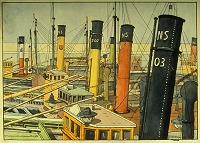Back to start | Man-made Hazards | Next
Obstacles

Although the sea covers a vast area, some parts of it are surprisingly crowded. This is especially true of inshore waters, but can also be said of some areas far out to sea. For example, many fishing boats head off together to fish in the same area or known fishing grounds. This leads to a danger of collision or of running into another boat's nets. Other ships such as merchant and cargo vessels also have to be avoided. During the 19th century the fisheries expanded. More and bigger boats increased the chances of collision. When fishing boats began to use steam at the end of the century there was a problem with the faster trawlers colliding with the slower sailing boats.
The fisherman's best tool in avoiding other users of the sea is a modern chart. These are published annually. They show the depth of the sea and the landmasses surrounding it. Also shown are the installations that could be a danger to vessels. These include fixed points such as oil and gas rigs, telecommunications cables, pipelines and so on. Areas of activity such as major shipping lanes and military exercise areas are also show on the charts.
Fishing boats often trail many miles of net behind them. This makes them particularly vulnerable to obstacles. The net is often run along the seabed where it can become snagged on lines or cables. This gear is very expensive so the fishermen will try very hard to save it. They are reluctant to cut it free when it becomes tangled. Fishermen can sometimes risk capsizing the boat if the weight of whatever is stuck is too great or the object too unyielding. Wrecks on the seabed are a particular danger as they attract fish that like to shoal in their shelter. It takes great skill to sail close enough to catch the fish without being caught oneself.
Back to start | Man-made Hazards | Next